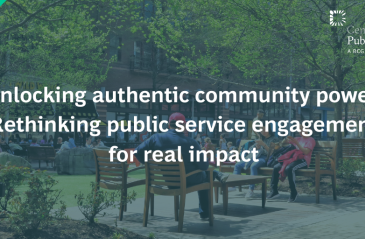
The power of storytelling in climate leadership

Finding fresh solutions to complex problems in new ways is the task facing @MaRSDD
Share articleDirector Joeri van den Steenhoven says that innovation takes place in three individual stages
Share articleGovernments now know they have to take innovation seriously, says van den Steenhoven
Share articleWe put our vision for government into practice through learning partner projects that align with our values and help reimagine government so that it works for everyone.
Joeri van den Steenhoven's job title may be "vice president of systems innovation", but perhaps a more accurate description would be "changemaker".
Change is what he lives and breathes. It's what he has been immersed in ever since leaving university and starting up Kennisland, one of the leading change labs in the Netherlands and Europe. It's what has propelled him into other organisations, including the Kafkabrigade - a research team that helps governments find and tackle red tape - and other positions, in the UK and Brussels. And now he is leading the fast-growing team at MaRS Solutions Lab, a Toronto-based innovation lab tasked with finding fresh solutions to complex problems in new ways.
He's the first to admit, though, that this is by no means a one-man show. "We are very much focused on how to solve the complex challenges which require system change," he explains. "And we do this by bringing together relevant stakeholders from government, industry, academia and not-for-profits. So we also serve as a neutral convener, which works on complex policy problems but not as part of government."
MaRS Solutions Lab is one element of Canada's largest innovation hub, MaRS. A not-for-profit organisation founded by civic leaders, the "MaRS" stands for Medical and Related Sciences but now has a much broader remit. It brings together educators, researchers, scientists, entrepreneurs and business experts under one roof in order to bridge the gap between the worlds of science, business and government. In other words, it gives entrepreneurs access to the people, capital and labs that can help them test and scale their ideas - an ideal place for someone like van den Steenhoven to take up residence.
The MaRS Solutions Lab was set up some four years ago. By then, van den Steenhoven was looking for a fresh challenge. "When I started Kennisland, it was a time when public innovation labs didn't exist and no one had a blueprint about how to build a knowledge economy. This was a complex challenge that required a new approach." he recalls.
"But over time we learned, and the organisation continues to exist today, but after 12 years I thought it was time to do something new. When I got the call from MaRS, they told me they wanted to set up a new innovation lab which is going to bring together the relevant stakeholders from government, industry and academia around the key challenges which will decide the kind of future the country will have. It sounded exactly what I was looking for and so, several months later, I relocated with my entire family to Toronto."
Since his arrival, the Solutions Lab has steadily grown in terms of personnel and projects. Underpinning its expansion has been the view that traditional approaches towards problem-solving are no longer sufficient. In today's complex world - one that is criss-crossed with problems and challenges aplenty - solutions will only emerge from collaboration between many different individuals and organisations.
"Innovation doesn't just happen," he points out. "In actual fact it takes place in three stages, and I'd like to think we add value to all three. The first is you actually have to understand the problem. A different perspective on the problem is often the starting point for any innovation. It's easy to organise a brainstorming workshop and have some nice creative ideas, but do you actually solve the problem? Especially in a government context, what you often see is that the problem is defined from an institutional perspective. But in a complex policy problem you can have 20 government agencies involved, each of them taking a piece of the legislation and each defining the problem differently, from their own perspective. Who is looking at it from a systems perspective and what the impact will be on the individual user? This is where we help."
The second and third stages are no less important, he continues. "The second stage is - if you know what the problem is you need to create the space for experimentation and the development of new ideas," he explains. "Again, this is where we can come in and support stakeholders as they seek to develop new ideas. Creating that space is often difficult, especially in the public sector where risk-taking is not rewarded. The paradoxical issue is that government's approach to managing the risks of innovation is often ill-conceived. ‘Let's run a pilot' seems to be the strategy. Prototyping in a lab offers more opportunities for testing before you invest in real-life pilots. There are different design thinking tools that can help here, like storyboarding or building it out in a model.
“And then the third stage is where I think innovation in the public sector can often go wrong. This is in the scaling-up phase after a successful pilot. This requires a good design of that experiment - not just running a simple pilot - and also requires thinking about evidence and evaluation, as well as effective scaling strategies, which is typically where we would assist. Because if new ideas do not get adopted and replace old ways of working, we can hardly speak of successful innovation."
One of van den Steenhoven's major priorities has been the Lab's recent report on regulating the sharing economy - an economic system in which assets or services are shared between private individuals, either free or for a fee, typically via the internet. The project sought to apply a Design perspective to the issue of how to regulate these affected markets, and was the result of a partnership between the Lab, the province of Ontario, and the city of Toronto.
In its report, which came out last year, van den Steenhoven and his colleagues sought to identify regulatory solutions that create public value, support innovation, and reduce administrative burden. “When it comes to introducing regulation for the sharing economy, governments should not only look at regulating new entrants but should also revisit current regulations to reduce burdens for existing operators,” he said at the time. “Governments should not just think of the sharing economy as something to respond to. They should think about what kind of sharing economy they want, and then develop a proactive strategy that helps build it.”
Twelve months on, he says that this project continues to exemplify the approach of the Lab to complex problems. "It started from a conversation with the province of Ontario," he recalls. "They asked us to help them redesign their regulations for the sharing economy, but we said that to do this effectively you have to include city leaders and industry, as we are all affected. It's a classic example of how we have tried to create a solution that provides public value and enables innovation to happen."
He goes on to say that it also enabled them to use their expertise on design-thinking. "Another key feature of our approach - and similar to CoLab - is that we combine design-thinking and system-thinking," he continues. "So while some of the other labs are mostly focused on redesigning services and service design, we use these techniques to really address those complex policy challenges. Examples include youth employment, health systems reform, and introducing entrepreneurial thinking into the education system. Or more recently, looking at how to change public procurement through codesign. These are the kinds of issues we typically work on."
As someone who has worked for and around different governments in different countries, van den Steenhoven is ideally placed to comment on how, or if, policymakers are getting better at the process of innovation. The good news is that he has observed a marked improvement over the years - and pinpoints two main factors that have spearheaded these changes.
"The first is that governments have realised that they have to take innovation seriously, and for this to happen you cannot rely on old systems and structures," he says. "If you look at the private sector, those companies that take innovation seriously actually have an innovation infrastructure, such as R&D labs and innovation teams, which are fully integrated into the organisation. More and more governments - in part following the lead of cities - have realised this, and this reflects the wave of innovation labs and the use of approaches like behavioural insights. Interventions like delivery units also show that governments have recognised that innovation is about more than just policy. But the challenge will be to move beyond these new initiatives towards a comprehensive innovation infrastructure inside government."
The second key change is that policymakers are now more willing to look outside government for answers. "Traditionally, government owned all the problems, so they would keep everything internal," he says. "But there is increasingly a realisation that they can't do it by themselves. How can any government solve something like climate change or understand how to regulate artificial intelligence, for example? Governments can use their convening power to bring together different organisations - like working with The Bill and Melinda Gates Foundation to tackle malaria in Africa. This also means that government needs to consider other levers of change - not just policy and regulation but instead creating partnerships with all kinds of actors and participants, sometimes industry, sometimes not-for-profits, sometimes foundations."
But even with this change of approach, van den Steenhoven is under no illusions about the scale of the task facing policymakers worldwide. "Governments are getting better at innovation," he says, "but in this fast-changing world they are also facing deeply complex problems that can't be fixed quickly. Problems that require systems change and therefore innovative approaches to address them effectively. This is where MaRS Solutions Lab has helped and will continue to help - long into the future."












